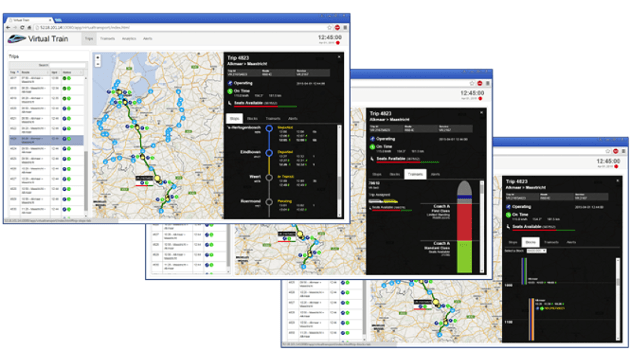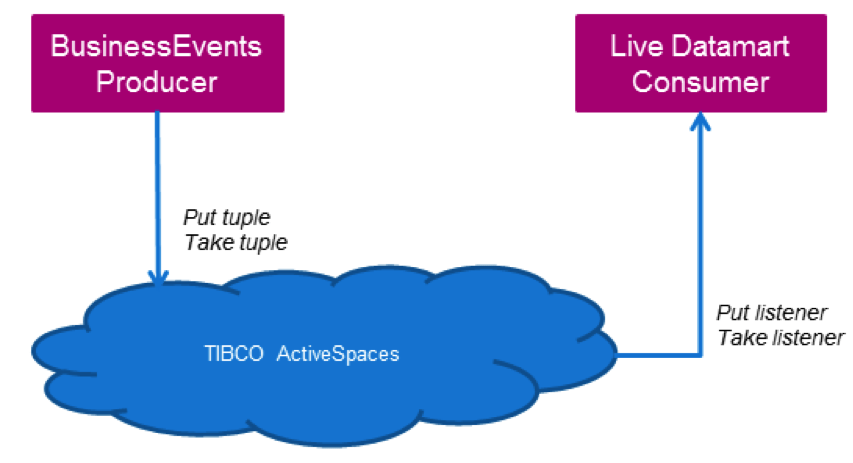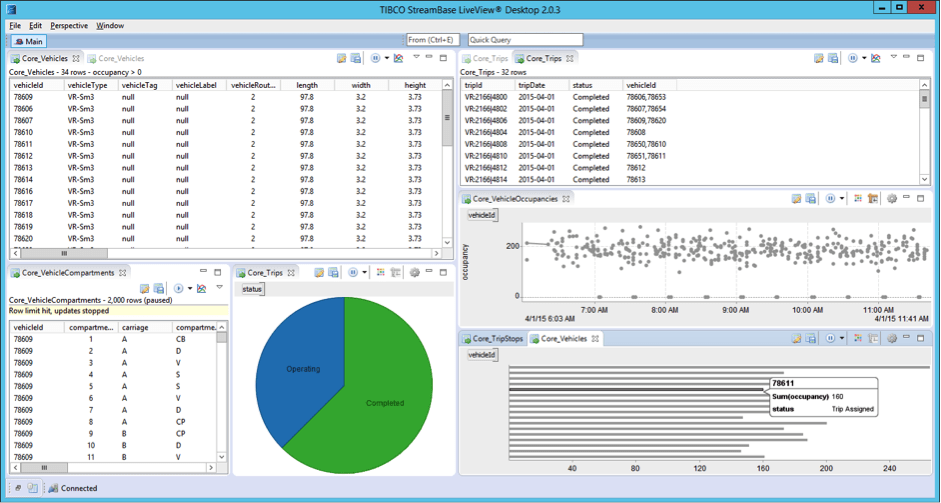
Say you’re a major European railway operator, and you want to embark on a game-changing exercise to fully model your equipment and infrastructure and track it all in real time. You envision building a complete, holistic model that will give you the competitive advantage you need to scale your business. This Virtual Transportation model is built on information from both centrally located event servers and event servers installed on-board trains. This platform then becomes the basis for rules and algorithms that will provide the capability of replay and simulation, as well as providing predictions and early warnings to the business.
This scenario is a perfect fit for BusinessEvents, which is a great tool for tracking and analyzing events flowing through your business. It models objects into complex hierarchies, performs stateful correlation over long duration, and executes rules based on triggering events and stored state. While BusinessEvents has business-friendly user interfaces, like WebStudio, for managing decision tables and rule templates, visualizing the actual data flowing through the system is not so easy. Say, we want to track trains in real time. The scope for human interaction with the data is not so extensive that our ability to make decisions and take action in real time would be limited. There are log files, but these are not business user-friendly, plus excessive logging can have an adverse impact on performance. Traditional business intelligence could be used by pushing data into a monitored database. But the best we can hope for is near real-time intelligence due to the batch nature of the tools. This could lead to delayed or missed opportunities to take corrective action during irregular railway operations.
This is where Live Datamart steps in. It’s like a data warehouse, but is attached directly to the streams of data coming out of the event processing platform. Data capture is true real time; the information is displayed immediately using thick or web clients and business users can take action while that information is still relevant. It can be used to animate trains moving on a map, display schedules as Gantt charts, and display occupancy and travel information on fully customized visual diagrams.
Integration Using ActiveSpaces
BusinessEvents and Live Datamart can be integrated using a couple of techniques. First, we can use ActiveSpaces as an intermediate layer.
For our railway, we will have one Live Datamart table tracking the position, speed, and bearing of all our trains. In ActiveSpaces one space is defined per Live Datamart table. When a train notifies the event server with an updated GPS position, BusinessEvents uses the ActiveSpaces channel to PUT this data into the train space.
On the other side, Live Datamart is configured with a Data Source EventFlow application that uses the ActiveSpaces operator. The operator listens for events on the train space and when a PUT event is detected with the new train position, the operator emits a tuple. This is published to the train table in Live Datamart. The datamart detects a change in the train position and notifies all interested clients through a query delta notification, and now our train position can be updated on the map in real time.

Integration Using Enterprise Messaging Service
While this technique works well in isolation, i.e where BusinessEvents and Live Datamart are the only components, our trains will gather information on the local event server before pushing notifications across a data link as messages. These messages go into the centralized infrastructure and may be used by any number of components. The second technique makes use of messaging as the intermediate layer.

Here Enterprise Message Service is the messaging layer. The event server on our train pushes speed and position reports over an LTE or Wifi link into the central messaging layer. BusinessEvents detects this and publishes notification messages on a JMS topic. These messages are bridged on to a dedicated queue for Live Datamart, providing guaranteed delivery.
Again in Live Datamart, a Data Source Event Flow listens to events on the queue using the JMS operator. When a message arrives the operator emits a tuple which is published to the train table in Live Datamart. Again, the datamart detects the change and notifies interested clients to update the map.
By decoupling event processing from the datamart we are not restricted to displaying only eventing data. When a train reports its position, it may provide only a unique identifier to keep messages small. We can use reference data to retrieve information about the train type, capacity, top speed, acceleration, deceleration, or any number of other parameters that can enrich the data going into Live Datamart to give business users the context to make their decisions.
Live Dashboards and Visualization for Controlled Actions
Once the integration between BusinessEvents and Live Datamart is set up, you can create live dashboards and visualizations. LiveView Desktop provides the ability to do this in the product out of the box. Tables, alerts, and charts can all be configured and displayed, all updated in real time.

Moving beyond the standard user interface, there are APIs available to build fully customized thick clients using Java or .NET, or rich thin clients using HTML5 and JavaScript.

These fully customized HTML5 dashboards all update in real time, and give the railway operator a view of where all the trips and trains are on an interactive map. Selecting a trip gives information about the trip status, occupancy status, and whether or not the trip is operating on time.
Further, drilldowns display a customized stop diagram with the status of each stop. This includes scheduled, estimated, and actual arrival and departure times. An equipment diagram gives a view at a glance which parts of the train are standing-room only and which parts have seats available. A block diagram can be used to show how the current trip fits into the overall schedule for the train for the service day. In the event of delays, this can be invaluable to operations in assigning equipment to the appropriate trips to minimize delays to customers.
Finally, the dashboard displays alerts that are published by the event server so that operations can take action. These can be either externally generated alerts or generated by the event server in the case of delays. Operations can also use this dashboard to create their own alerts which are then reflected in the Virtual Transportation model.
With all these capabilities we have a true real-time view of what’s happening in the network. Instant, visual feedback on transit network health, and real-time control over risks and issues allow the railway to be proactive in managing exceptions rather than reactive. And in a world of demanding customers, competitive pressures, cost constraint, and increasing regulatory oversight, the ability to mitigate and correct problems before your customers know they even exist is a real game-changer.
To learn more from Glenn about the integration of TIBCO BusinessEvents and TIBCO Live Datamart with messaging and data grid, check out our on-demand webinar.





